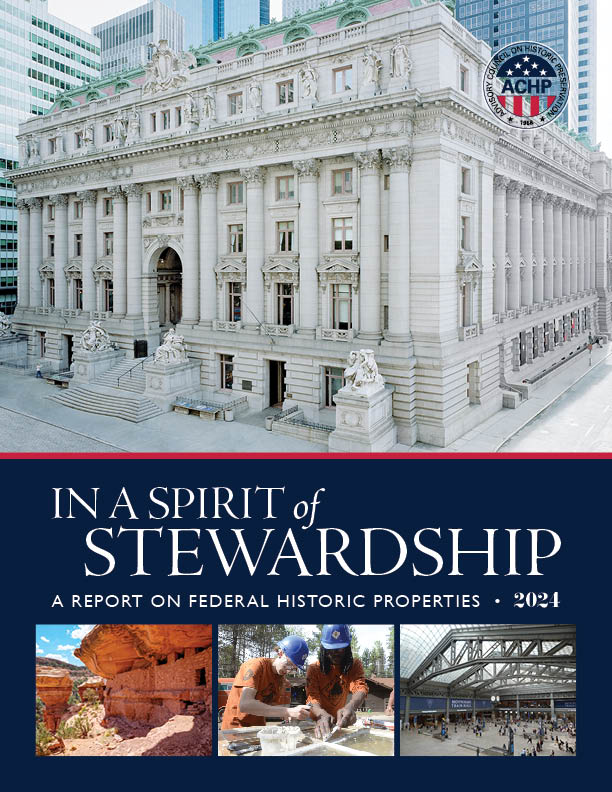WASHINGTON D.C.—The Advisory Council on Historic Preservation (ACHP) presented President Joseph R. Biden Jr. with In a Spirit of Stewardship: A Report on Federal Historic Properties, a report surveying federal government stewardship of historic properties and leadership in promoting historic preservation priorities alongside climate change response, equity, infrastructure, and job creation.
R. Biden Jr. with In a Spirit of Stewardship: A Report on Federal Historic Properties, a report surveying federal government stewardship of historic properties and leadership in promoting historic preservation priorities alongside climate change response, equity, infrastructure, and job creation.
As owner and steward of a vast array of historic properties, the federal government plays a centrally important role in advancing the American preservation ethic. This report is the seventh of its kind in 20 years, produced pursuant to Executive Order (EO) 13287, “Preserve America,” and highlighting the efforts of federal agencies and officials to identify, protect, and use historic properties in their care–and to inspire the expansion of such efforts.
“This report demonstrates how the federal government is working to balance the important goal of preserving and protecting our nation’s history with other economic, environmental, and cultural goals” ACHP Chair Sara C. Bronin said. “The ACHP and other federal agencies and officials must continue to ensure that preservation itself endures as an American value, a source of pride, and a community benefit for many more decades to come.”
The report has several key findings:
- Climate responsiveness: Faced with the challenges of resiliency and preparedness for climate change, the federal government is working collaboratively to identify and protect historic properties, and to incorporate equity and the input and participation of parties with special expertise in the preservation of historic, cultural, and natural resources affected.
- ACHP highlight: The ACHP’s newly adopted policy on climate change and historic preservation encourages shifts in agency practices, collaboration, and training to accelerate these efforts.
- Flexibility in permitting: To both protect the places Americans value and facilitate access to infrastructure and investments, federal agencies are using flexible legal tools to plan for, manage, and evaluate the impacts of their actions on historic properties.
- ACHP highlight: The ACHP has worked with federal agencies to fast-track electric vehicle charging infrastructure, military and veterans housing, transmission lines, and large-scale forest restoration.
- The development of partnerships: Partnerships are leveraging limited federal resources and providing important benefits to federal agencies in the identification, protection, and use of historic properties, while enabling important educational and job training opportunities and the promotion of a diverse workforce.
- ACHP highlight: Among other internships, workforce and trades training, and innovative opportunities is the ACHP-U.S. Forest Service “Cultural Heritage in the Forest” program, geared toward students at Historically Black Colleges and Universities.
- An emphasis on consultation: Active collaboration and timely involvement with Indian Tribes and Native Hawaiian organizations in property management activities, climate preparedness, and infrastructure planning enhances outcomes and remains critically important.
- ACHP highlight: Among other demonstrations of the federal government’s commitment to upholding its trust responsibility with Indian Tribes and Native Hawaiians, last year, the ACHP adopted a policy involving burial sites, human remains, and funerary objects, which aims to improve treatment of these sites and descendant communities.
- A changing federal workplace: Increases in remote work and telework as a result of the COVID-19 pandemic have led federal decision makers to evaluate their office space needs and seek opportunities for adapting underutilized space, including historic buildings and facilities. Virtual meeting applications, tours, education programs, and programming have assisted in expanding federal agency outreach.
The “Preserve America” executive order, signed by President George W. Bush, is premised on the sound principle that preserving our heritage and using heritage assets to meet contemporary needs is a wise investment in our future and a bipartisan priority. Learn more.